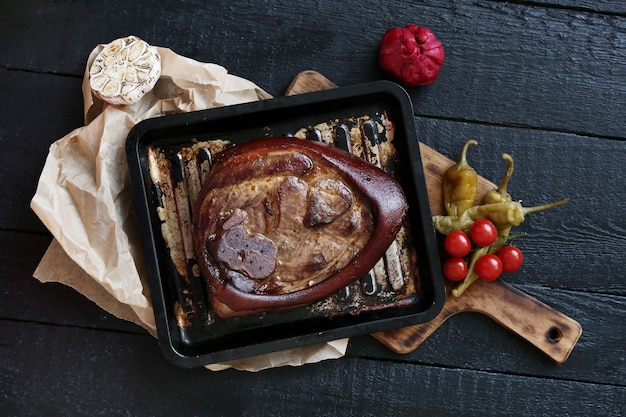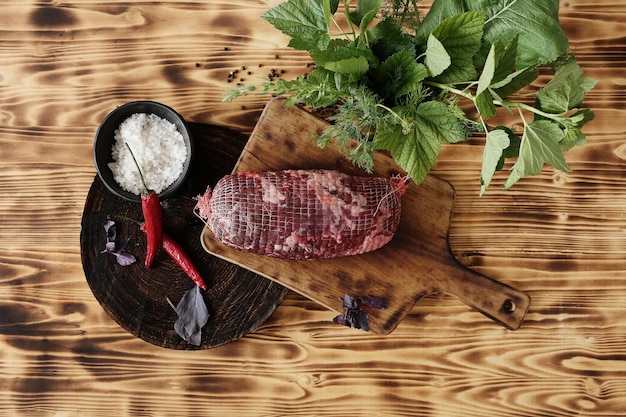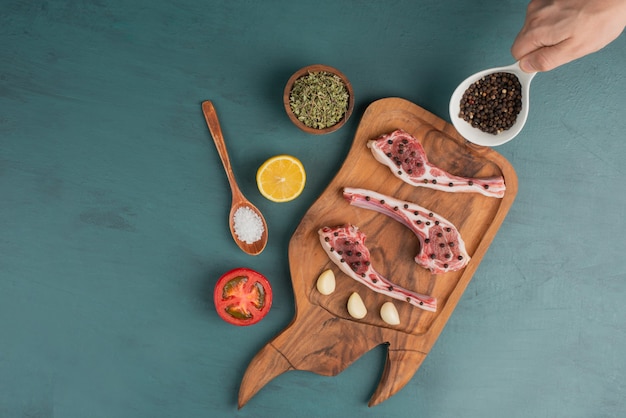There's nothing quite like a beautifully cooked ribeye, and when you've got a bone-in roast, you're talking about a culinary experience that's truly special. It's not just about dinner; it's about creating a memorable occasion. I'm not just tossing out recipes here, I'm sharing years of experience, the wisdom I've gathered through trial and error, all in the pursuit of achieving the perfect ribeye roast. We're going to dive into every stage, from choosing the right cut to mastering the art of resting and carving. Grab your apron, because this is a journey to culinary nirvana.
(Part 1) Choosing Your Weapon: The Ribeye Roast

The first step, and arguably the most important, is selecting your ribeye. You want a piece of meat that's going to impress, and that starts with the right cut. A bone-in ribeye roast is going to give you the best flavor and tenderness, but there are a few key things to look for.
The Marbling
Picture this: intricate, delicate streaks of fat running through the muscle. That's marbling, and it's the secret ingredient to a juicy, flavorful roast. Think of it as nature's built-in basting system. The more marbling, the richer the flavor and the more tender the meat will be. You want to see that fat, but it shouldn't be overwhelming, just evenly distributed throughout the meat. It's a delicate balance, and a good butcher will be able to point out the perfect marbling.
The Bone
The bone, my friends, is a game-changer. It adds depth of flavor, infuses the meat with a savory essence, and helps the roast cook more evenly. A good ribeye roast will have a decent-sized bone running down the center, and it's going to add a bit of rustic charm to the whole presentation. Plus, there's something undeniably satisfying about carving around that bone, a bit of a culinary ritual.
The Weight
Don't be shy! A ribeye roast is a statement piece, a culinary centerpiece that demands attention. You want enough meat to feed a crowd, or at least have enough leftovers for some seriously delicious sandwiches. Aim for a roast that weighs at least 4-5 pounds, which will give you ample portions and allow you to experiment with different cooking methods. It's all about creating an abundance, a celebration of flavor.
The Butcher's Wisdom
Don't be afraid to ask for advice from your butcher. They are experts, they know their meat. Let them guide you, they'll be able to help you choose the perfect ribeye roast for your needs. Tell them what you're planning to cook, the size of your party, and your preferred level of doneness. They'll be happy to help you find the ideal cut.
(Part 2) Prepping for the perfect roast

Now that you've got your ribeye hero, it's time to set the stage for culinary success. We're not just throwing this roast in the oven and hoping for the best. There's an art to getting it perfectly cooked, and it starts with the prep.
Bringing It to Room Temperature
The key here is patience, my friend. Don't rush this step. Let that roast sit out on the counter for at least an hour, maybe two, before cooking. This allows the meat to come to room temperature, which will help it cook more evenly. Imagine it as the meat getting ready for its big moment in the oven. It's a chance for the internal temperature to stabilize, ensuring that the roast cooks from the inside out. The extra time is well worth it, trust me.
Pat It Dry
Once the ribeye has reached room temperature, give it a good pat dry with paper towels. This is important for getting a nice crispy sear. You want the heat to concentrate on browning the surface, not steaming the meat. It's all about that beautiful golden-brown crust, a sign of a perfectly cooked roast.
Seasoning: The Spice of Life
Now, let's talk seasoning. The beauty of a ribeye roast is that it really doesn't need much. Keep it simple and let the meat shine. I'm a big fan of salt and pepper, freshly ground, of course. Don't be shy, but also don't go overboard. Season liberally, but don't bury the meat in salt. You want to enhance the natural flavors, not mask them.
Beyond the Basics
If you want to add a touch of extra flavor, try a simple rub. A mixture of herbs like rosemary, thyme, and oregano, or a blend of spices like garlic powder, onion powder, and paprika can add a wonderful depth of flavor. But remember, keep it simple and focus on enhancing the natural flavor of the ribeye.
(Part 3) Masterful Methods: cooking techniques

Alright, here's where things get exciting. You've got your perfect ribeye, it's prepped and ready to go, now it's time to cook it. I'll tell you my two favorite methods, and I'm sure you'll agree, both are excellent.
The Searing Method
This is the classic approach, and for good reason. It's all about creating that irresistible crust, locking in the juices, and ensuring a perfectly cooked roast. Here's the breakdown:
- Get your oven preheated to 450°F (232°C). You want that oven nice and hot.
- Use a cast iron skillet or a heavy-bottomed pan. Heat it over medium-high heat until it's smoking hot. This is essential for getting that perfect sear.
- Carefully sear the ribeye on all sides for about 3-4 minutes per side. You'll see a beautiful, golden-brown crust forming. Don't worry if it seems like it's cooking too fast, the oven will finish the job.
- Transfer the roast to a roasting pan and continue cooking for about 15-20 minutes per pound, or until the internal temperature reaches 130°F (54°C) for medium-rare. I always recommend using a meat thermometer for accuracy.
- Rest the roast for at least 15 minutes before carving. This is crucial for letting the juices redistribute and make the meat incredibly tender.
The reverse sear Method
Now, this one is a bit more nuanced, but I'm a big fan. It involves cooking the roast slowly at a low temperature, followed by a quick sear. This method ensures incredibly tender and juicy meat, perfect for a large roast. Here's how it works:
- Preheat your oven to 275°F (135°C) - the temperature of slow, gentle cooking.
- Place the ribeye roast in a roasting pan and cook for about 2 hours, or until the internal temperature reaches 120°F (49°C) for medium-rare. Remember, use a meat thermometer for accuracy.
- Turn your oven up to 450°F (232°C). While the oven is heating up, remove the roast and let it rest for about 15 minutes.
- Now, use the same searing method as described above, searing the roast for 3-4 minutes per side to create that delicious crust. The quick sear will lock in the juices and create a beautiful crust.
- Let the roast rest again for at least 15 minutes before carving. This is crucial to let the juices redistribute.
(Part 4) The Don't-Forget-It: The Resting Phase
Alright, the roast is cooked, but we're not quite there yet. The resting phase is crucial. It's like a little secret weapon that makes all the difference in the world. Think of it as the meat's time to cool down, relax, and reabsorb those delicious juices. Let that roast rest for at least 15 minutes, but I'd say 20-30 minutes is even better. Don't skip this step! This crucial step allows the juices to distribute evenly throughout the meat, ensuring tenderness and a burst of flavor when you finally carve it. You'll be amazed at how much more flavorful and tender the meat becomes after resting.
(Part 5) The Moment of Truth: Carving the Roast
Now, this is the fun part! You've cooked the perfect roast, it's rested, and it's time to carve. This is where you get to show off all your culinary prowess. But don't worry, it's not as intimidating as it sounds.
The Right Tools for the Job
Get yourself a sharp carving knife. This isn't the time to be fiddling around with a dull blade. A good carving knife will make slicing those beautiful slices a breeze. A carving fork is also a handy tool for holding the roast in place while you carve.
The Art of Carving
Start by carving slices perpendicular to the bone. You'll get nice, even slices. If you're dealing with a really thick roast, you can carve the slices in half lengthwise. Don't worry about making perfect slices, a bit of rustic charm is perfectly acceptable. Just be careful not to over-carve, as this can lead to a dry roast. Take your time and enjoy the process.
(Part 6) A Feast Fit for a King: Serving and Accompaniments
Alright, you've got your beautifully carved roast, now it's time to make it a feast. This is where your creativity takes center stage.
The Star of the Show
Serve your ribeye roast hot, right off the carving board. The aroma alone is enough to make anyone's mouth water. Arrange the slices artfully on a platter, and don't forget to showcase that beautiful bone.
Complementary Companions
Think about what you want to pair with your ribeye. Classic sides like roasted potatoes, asparagus, or a medley of root vegetables always work well. A simple salad with a vinaigrette dressing will add a touch of freshness. But don't be afraid to experiment. A creamy risotto, a vibrant green bean casserole, or even a tangy coleslaw can be delightful pairings. It's all about balance and creating a symphony of flavors.
The Perfect Pairing
And let's not forget about the wine. A full-bodied red wine like a Cabernet Sauvignon, Merlot, or Shiraz will perfectly complement the richness of the ribeye. The tannins in these wines will cut through the richness of the meat, creating a harmonious balance. But if you prefer a lighter wine, a Pinot Noir or a Zinfandel can also be a good choice. Ultimately, it comes down to personal preference.
(Part 7) The Leftovers: A Culinary Treasure
The beauty of a ribeye roast is that you'll likely have leftovers. And believe me, these leftovers are a culinary treasure. Don't think of them as mere leftovers, think of them as opportunities for new culinary adventures. There are countless ways to repurpose that delicious ribeye.
The Ultimate Sandwich
Let's be real, a leftover ribeye sandwich is the ultimate comfort food. Slice some of that delicious roast, throw it on a toasted bun with a bit of cheese, maybe some caramelized onions, and you've got yourself a culinary masterpiece. You can even add a dollop of horseradish cream for a bit of zing. It's simple, satisfying, and absolutely irresistible.
Reimagined Dishes
Don't be afraid to get creative. Leftover ribeye can be used in a variety of dishes. Try adding it to a pasta dish, a soup, or even a salad. The possibilities are endless! Imagine a creamy pasta with a rich ribeye sauce, or a hearty soup with chunks of ribeye and vegetables. The flavor of the ribeye will elevate any dish.
(Part 8) Mistakes and Troubleshooting: Learning from Experience
You know what they say, even the best chefs make mistakes. And trust me, I've had my share of less-than-perfect ribeye roasts. But that's part of the learning process. Here are some common mistakes and how to avoid them.
Overcooked Roast
Don't be afraid to use a meat thermometer! It's your best friend when it comes to ensuring the perfect cook. If you overcook your roast, it will be dry and tough. Don't worry, you can still salvage it by slicing it thinly and using it in a sandwich or other dish. You can also try adding some sauce or gravy to help moisten the meat.
Unevenly Cooked Roast
Make sure you're cooking the roast at the right temperature and for the right amount of time. If you notice that one side of the roast is cooking faster than the other, you can rotate the roast in the oven. Another tip is to tent the roast with foil for a few minutes if it seems like it's browning too quickly.
Under-Seasoned Roast
Don't be afraid to season your roast liberally. Salt and pepper are essential for bringing out the flavor of the meat. If you find that your roast is under-seasoned, you can always add more salt and pepper after it's cooked. A little bit of extra seasoning can go a long way.
(Part 9) The Verdict: A Delicious Journey
There you have it, my complete guide to cooking the perfect bone-in ribeye roast. It's a journey, and like all journeys, it has its ups and downs. But trust me, the end result is worth it. The satisfaction of serving a beautifully cooked ribeye to your family and friends is truly something special. It's about creating an experience, a culinary masterpiece that will be remembered.
FAQs
How long should I rest a ribeye roast before carving?
A ribeye roast should rest for at least 15 minutes, but ideally 20-30 minutes, before carving. This allows the juices to redistribute throughout the meat, making it more tender and flavorful. It's like a little magic trick that transforms the meat into a culinary delight.
What temperature should I cook a ribeye roast to?
The recommended internal temperature for a ribeye roast is 130°F (54°C) for medium-rare, 135°F (57°C) for medium, and 140°F (60°C) for medium-well. Use a meat thermometer for accuracy. Remember, everyone has their own preference for doneness, so adjust the temperature accordingly.
What are some good side dishes to serve with a ribeye roast?
Classic side dishes like roasted potatoes, asparagus, or a medley of root vegetables are great options. A simple salad with a vinaigrette dressing will add a touch of freshness. But don't be afraid to experiment. A creamy risotto, a vibrant green bean casserole, or even a tangy coleslaw can be delightful pairings. It's all about creating a symphony of flavors that complement the richness of the ribeye.
What kind of wine should I pair with a ribeye roast?
A full-bodied red wine like a Cabernet Sauvignon, Merlot, or Shiraz will perfectly complement the richness of the ribeye. The tannins in these wines will cut through the richness of the meat, creating a harmonious balance. But if you prefer a lighter wine, a Pinot Noir or a Zinfandel can also be a good choice. Ultimately, it comes down to personal preference.
What should I do if I overcook my ribeye roast?
If you overcook your ribeye roast, it will be dry and tough. Don't worry, you can still salvage it by slicing it thinly and using it in a sandwich or other dish. You can also try adding some sauce or gravy to help moisten the meat. Remember, even the best chefs have their slip-ups. Embrace the experience, and don't be afraid to get creative with your leftovers!
Go on, give it a try. You'll be amazed at how easy it is to create a delicious and memorable meal. And remember, even if you make a mistake, it's all part of the fun! Happy cooking.
Everyone is watching

How to Cook Frozen Lobster Tails Perfectly: A Step-by-Step Guide
RecipesLobster. Just the word conjures up images of lavish meals, special occasions, and a taste of luxury. But let's...

Pigs in a Blanket Cooking Time: How Long to Bake for Perfect Results
RecipesAh, pigs in a blanket. Just the name conjures up images of those delightful little parcels of crispy pastry en...

Pork Fillet Cooking Time: How Long to Cook It Perfectly
RecipesPork fillet, or tenderloin as it's sometimes called, is a real favourite in our house. It's so versatile, and...

The Ultimate Guide to Cooking Delicious Frankfurters
RecipesLet's face it, we all love a good frankfurter. It's a classic, simple, and always satisfying. But let's be rea...

Wolf Meat Recipes: A Guide to Cooking Wild Game
RecipesLet's be honest, you don't see wolf meat at your local butcher shop every day. It's a bit of a wild card, but ...
